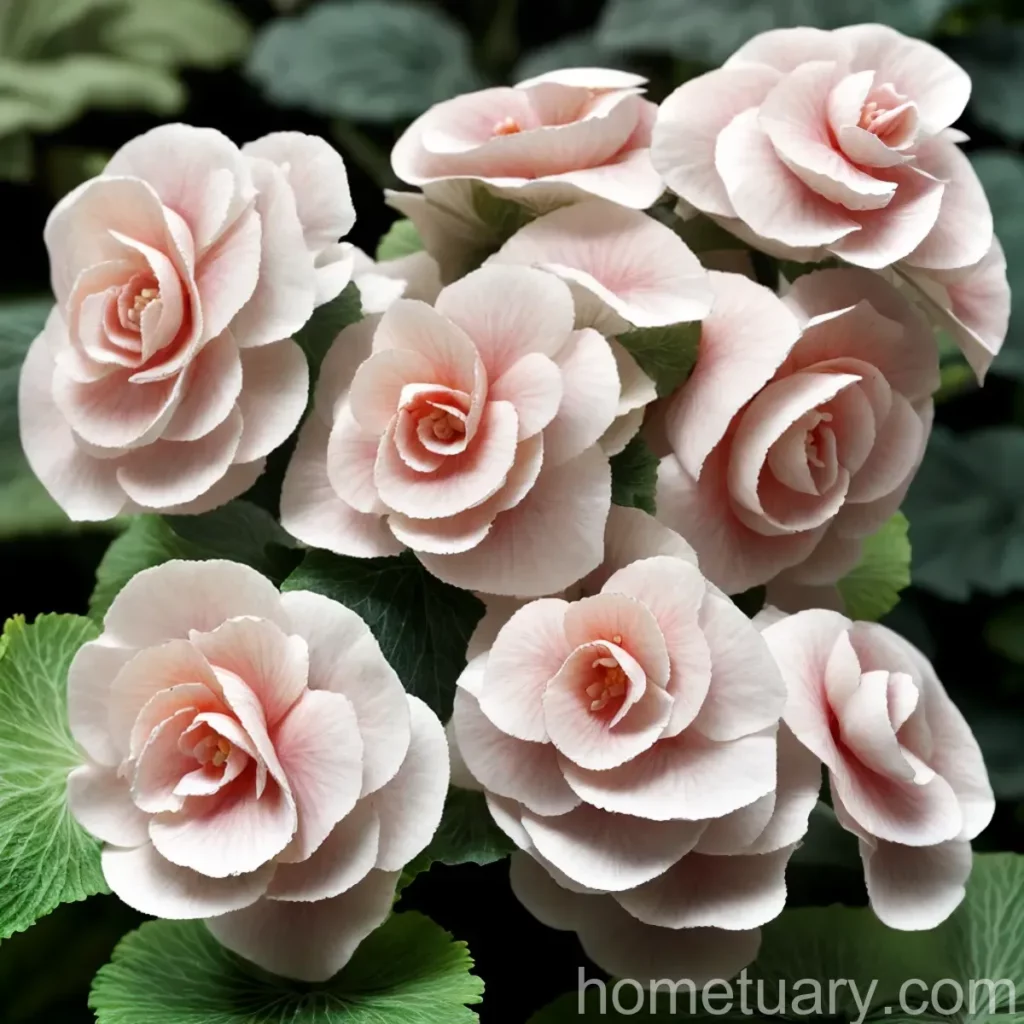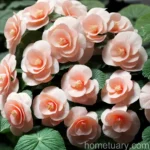Hybrid Tuberous Begonia (Begonia x tuberhybrida ‘Jurassic Silver Swirl’)
In the world of horticulture, the hybrid tuberous begonia, scientifically known as Begonia x tuberhybrida ‘Jurassic Silver Swirl’, stands out as a stunning and versatile plant. This blog post delves into all aspects of caring for this unique begonia variety, from its culture and uses to common diseases and pests. Whether you’re a novice gardener or a seasoned plant enthusiast, this comprehensive guide aims to equip you with the knowledge needed to nurture and appreciate the beauty of the ‘Jurassic Silver Swirl’ begonia.
What is a Plant: Hybrid Tuberous Begonia (Begonia x tuberhybrida ‘Jurassic Silver Swirl’)
Before delving into the specifics of caring for the hybrid tuberous begonia, it’s essential to understand the plant itself. The Begonia x tuberhybrida ‘Jurassic Silver Swirl’ belongs to the Begoniaceae family and is a hybrid of various Begonia species, resulting in its unique characteristics.
Key Takeaways – Hybrid Tuberous Begonia (Begonia x tuberhybrida ‘Jurassic Silver Swirl’)
- Culture
- Uses
- Water
- Sunlight
- Fertilizer
- Soil
- Pruning
- Propagation
- Container
- Popularity
- Common Diseases
- Disease Diagnosis
- Common Pests
- Botanist’s Tips
- Fun Facts
- Links to External Resources
Without further ado, let’s explore the intricacies of caring for this captivating begonia and appreciate the nuances that define it.
Culture of Hybrid Tuberous Begonia
Uses
The hybrid tuberous begonia serves multiple purposes, ranging from ornamental gardening to indoor decor. Its vibrant and patterned foliage, coupled with delicate flowers, makes it a popular choice for adding a splash of color to gardens, hanging baskets, and containers. Additionally, it can be grown indoors, adding a touch of natural beauty and elegance to interior spaces.
Water
Ensuring the right balance of water is crucial for the health of the ‘Jurassic Silver Swirl’ begonia. Although it requires consistent moisture, overwatering can lead to root rot and other issues. Water the plant when the top inch of the soil feels dry, and ensure that excess water can drain freely from the container.
Sunlight
Optimal sunlight conditions play a significant role in the growth and flowering of this begonia variety. It thrives in partial shade to filtered sunlight, making it suitable for locations with dappled sunlight or areas with indirect sunlight. Protecting it from harsh midday sun can prevent leaf scorch and maintain the begonia’s health and vigor.
Fertilizer
Feeding the hybrid tuberous begonia with a balanced, water-soluble fertilizer can promote healthy growth and abundant flowering. During the active growing season, fertilize the plant every 2-4 weeks to provide it with essential nutrients. It’s important to follow the recommended dosage to avoid over-fertilization, which can adversely impact the plant’s well-being.
Soil
The ‘Jurassic Silver Swirl’ begonia thrives in well-draining, humus-rich soil with a slightly acidic to neutral pH. A good-quality potting mix designed for begonias or a blend of peat moss, perlite, and organic matter can create an optimal growing medium for this begonia. Additionally, providing adequate aeration and moisture retention in the soil can contribute to the plant’s overall health.
Pruning
Regular pruning is essential for maintaining the begonia’s shape, encouraging bushier growth, and removing spent flowers and damaged foliage. It’s advisable to use sterile pruning tools to prevent the spread of diseases and to trim the plant as needed throughout the growing season. Furthermore, removing any leggy or unruly growth can promote a more compact and visually appealing appearance.
Propagation
Propagating the ‘Jurassic Silver Swirl’ begonia can be achieved through leaf cuttings or division of tubers, allowing for the expansion of your begonia collection or the sharing of its beauty with others. Taking leaf cuttings from healthy, mature leaves and following proper propagation techniques can result in new plants with the same charming characteristics as the parent plant.
Container Popularity
The ‘Jurassic Silver Swirl’ begonia’s suitability for container gardening has contributed to its popularity among plant enthusiasts. Its compact size, attractive foliage, and vibrant blossoms make it an ideal choice for containers, hanging baskets, and window boxes. This versatile plant can thrive as a standalone container specimen or as part of a multi-plant arrangement, enhancing the aesthetics of any outdoor or indoor space.
Common Diseases
Like any plant, the hybrid tuberous begonia is susceptible to certain diseases, and being aware of these potential issues is crucial for its care and maintenance.
Disease Diagnosis
Botrytis Blight: Commonly known as gray mold, botrytis blight can affect begonias, leading to the development of brown spots, wilting, and the formation of gray fungal growth on the foliage and flowers. This fungal disease often thrives in humid conditions and can be managed through proper ventilation, avoiding overhead watering, and the removal of affected plant parts.
Powdery Mildew: Powdery mildew manifests as a white powdery coating on the leaves and stems of the hybrid tuberous begonia. It can hinder photosynthesis and weaken the plant if left unchecked. Maintaining good air circulation, avoiding overcrowding of plants, and applying fungicidal sprays can help control and prevent the spread of powdery mildew.
Common Pests
Aphids
Aphids are a common nuisance for many plant varieties, including the hybrid tuberous begonia. These small, soft-bodied insects can cause damage by feeding on the plant’s sap and excreting honeydew, leading to the development of sooty mold. Regular monitoring, physical removal, and the use of insecticidal soap can effectively manage aphid infestations.
Thrips
Thrips are tiny, slender insects that can cause stippling, distortion, and silvering of leaves by feeding on the begonia’s tissue. Employing preventive measures such as maintaining a clean growing environment, using reflective mulches, and introducing natural predatory insects can aid in controlling thrips and minimizing their impact on the plant’s health.
Spider Mites
Spider mites are microscopic pests that can infest the ‘Jurassic Silver Swirl’ begonia, resulting in webbing, stippling, and premature leaf drop. These pests thrive in dry and warm conditions, making it essential to increase humidity, regularly inspect the plant for early signs of infestation, and apply targeted miticides to mitigate their presence.
Botanist’s Tips
- Regular Monitoring: Observing the begonia for any changes in growth, foliage color, or the presence of pests can help detect issues early and facilitate prompt intervention.
- Consistent Care: Providing the begonia with a stable environment, regular watering, appropriate lighting, and nourishment ensures its overall well-being and resilience.
- Gentle Handling: Being mindful of the begonia’s delicate nature during potting, transplanting, and maintenance activities can prevent mechanical damage and stress to the plant.
Fun Facts
- Some begonia species, including tuberous begonias, are edible and have been used in traditional medicine for various purposes.
- Begonias are named after Michel Bégon, a former governor of the French colony of Haiti, reflecting their historical connection to exploration and horticulture.
Links to External Resources
In essence, the hybrid tuberous begonia, particularly the ‘Jurassic Silver Swirl’ variety, embodies a blend of elegance, resilience, and horticultural charm. By understanding its culture, addressing potential challenges, and appreciating its intrinsic beauty, plant enthusiasts can cultivate a deep admiration for this remarkable begonia species.
To conclude, this comprehensive guide to caring for the ‘Jurassic Silver Swirl’ begonia aims to equip individuals with the knowledge and insights needed to nurture and enjoy the captivating allure of this exceptional plant.
References
- Winston, J. (2019). Begonias. Portland, OR: Timber Press.
- Miller, G. W. (Ed.). (2013). The Encyclopedia of Begonias. Portland, OR: Timber Press.
- Robinson, R. G. (2016). Growing Begonias: A Complete Guide. Portland, OR: Timber Press.















